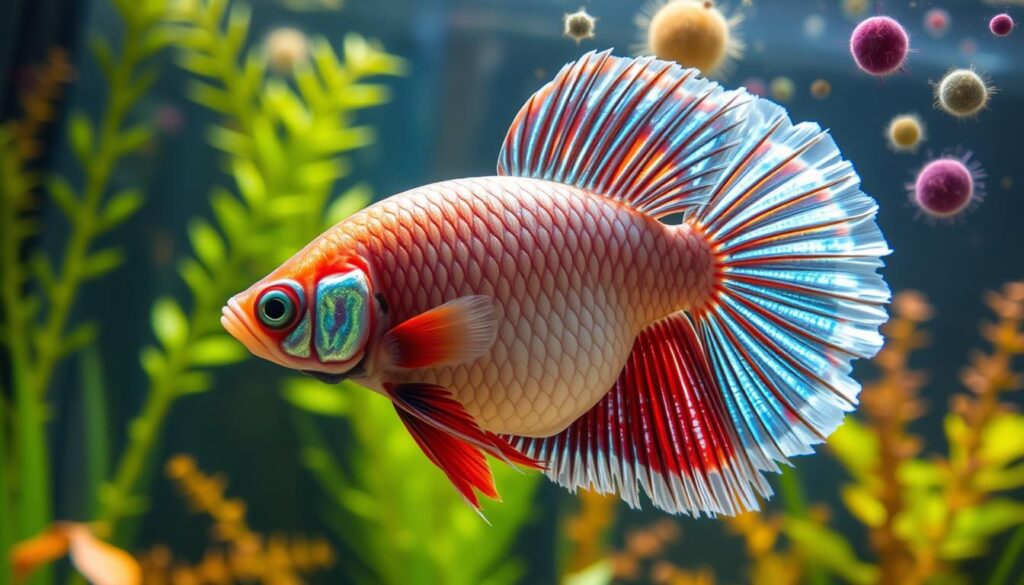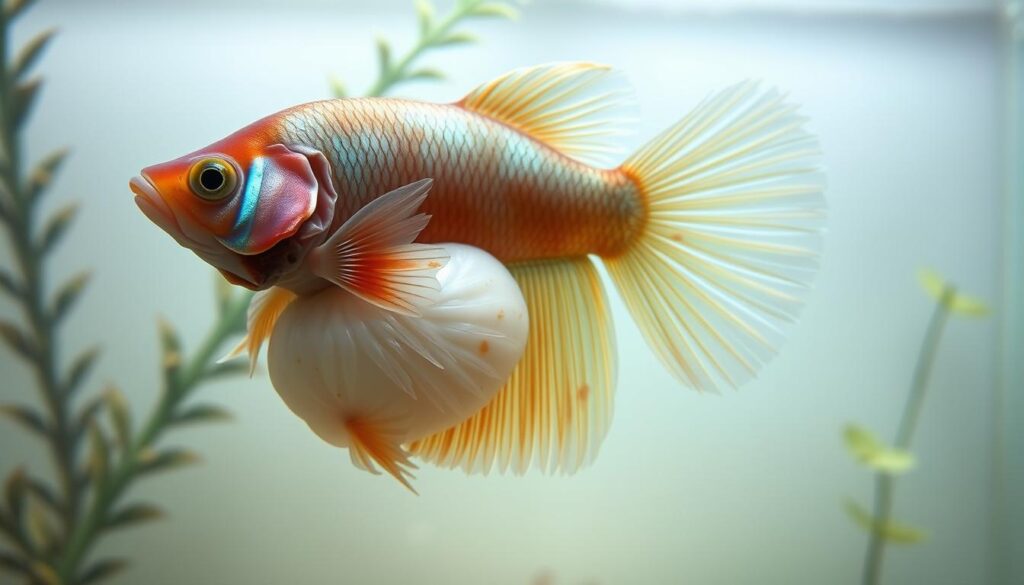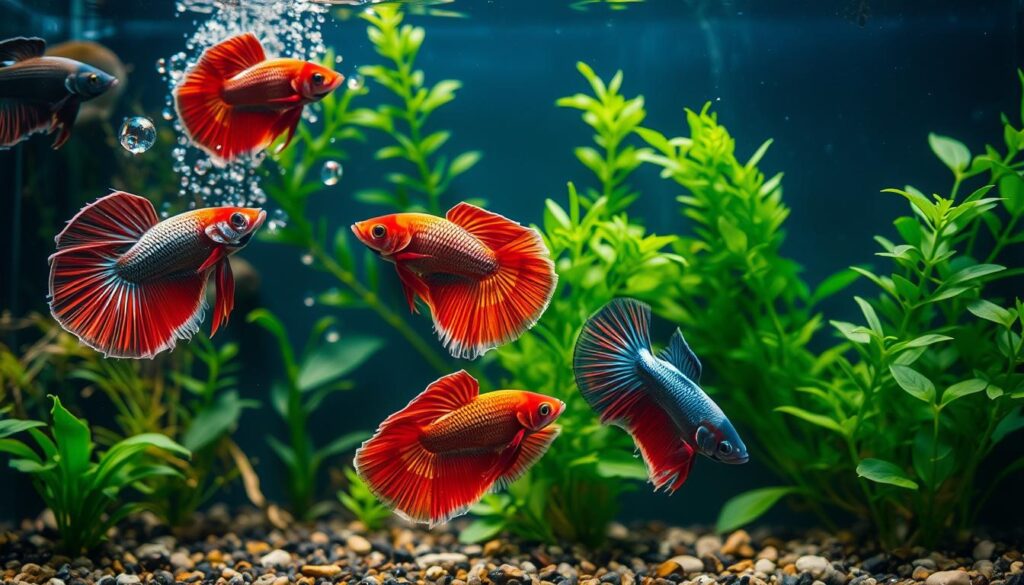I’ve always been drawn to the beauty of betta fish. But, like many, I’ve faced the sad condition of dropsy. It’s not a disease, but a sign of another issue inside, like a bacterial infection or parasite1. Dropsy is a sign of kidney or gill problems, caused by other health issues2.
It’s important to know the causes of dropsy to treat it well and stop it from happening. So, I want to share what I’ve learned about dropsy in betta fish, its causes, and how to prevent it.
Key Takeaways
- Dropsy in betta fish is a secondary symptom of another problem, often caused by bacterial infections, viruses, or parasites.
- Poor water quality is a common cause of dropsy, leading to chronic stress and kidney dysfunction3.
- Regular monitoring of water quality is essential to prevent conditions that can lead to dropsy1.
- Effective treatment of the underlying illness can resolve dropsy, but it can be fatal if left untreated2.
- Understanding the causes of dropsy is crucial to providing effective treatment and preventing its occurrence.
- Dropsy can be contagious if caused by bacteria, viruses, or parasites, affecting other fish within the same tank3.
- Older betta fish are more susceptible to kidney failure and other infections, increasing their risk of developing dropsy1.
- Read Also How to Treat Velvet Disease in Betta Fish: A Quick Guide
Understanding Dropsy in Betta Fish: A Fish Keeper’s Guide
As a fish keeper, knowing about dropsy is key. It’s not a disease but a sign of another problem. Finding the real cause is crucial for treating it4. Dropsy shows up when kidneys or gills don’t work right, often due to poor health.
Many things can lead to dropsy in betta fish. Bad water quality, infections, and stress are common causes. Keeping your fish in good conditions helps avoid these problems.
Some common reasons for dropsy include small tanks and poor water flow5. Beginners often make mistakes that lead to dropsy. Keeping betta fish in small, dirty tanks is a big no-no4. To stop dropsy, keep the water clean, provide a nice home, and watch your fish closely.
Here are some key points to consider when dealing with dropsy in betta fish:
- Poor water quality is a common cause of dropsy6
- Bacterial infections can contribute to the development of dropsy4
- Environmental stressors, such as sudden changes in temperature or water chemistry, can trigger dropsy5
Understanding dropsy helps you prevent and treat it in your betta fish. Always keep the water clean, provide a good home, and watch your fish’s health. This way, you can lower the risk of dropsy4.
Read Also What Causes Dropsy in Betta Fish? Symptoms, Causes, and Effective Treatments
Identifying Dropsy in Your Betta Fish
To spot dropsy in your betta fish, keep an eye on their body and behavior changes. Dropsy makes the body swell and scales look like pinecones7. It’s often caused by bad water quality, affecting about 30-40% of betta fish in poor environments8.
Look out for these physical signs:
- Swelling of the body
- Pine coning of scales
- Bulging eyes
These signs might mean your fish has an illness, like a bacterial or parasitic infection. Such infections can hit up to 20% of ornamental fish in farms9.
Behavioral changes are also important to notice. Look for signs like being very tired, not wanting to eat, and breathing hard. Spotting these early can save your betta fish’s life. With the right care, you can keep your betta healthy and happy.
| Symptom | Description |
|---|---|
| Swelling of the body | Extreme swelling of the body, often accompanied by pine coning of scales |
| Bulging eyes | Eyes that appear bulged or protruding from the head |
| Lethargy | Lack of energy or activity, often accompanied by loss of appetite |
Watching your betta fish closely can help you catch dropsy early. Keep the water clean, feed them well, and make sure their home is safe and comfy789.
What Causes Dropsy in Betta Fish: A Comprehensive Overview
Exploring betta fish dropsy origins, I found it’s often due to a gram-negative bacterial infection. This can be caused by stress, poor water quality, and other factors10. Knowing what causes dropsy is key to treating it and stopping it from happening. Dropsy explanations often highlight bacterial infections, bad water quality, and other factors that lead to it.
Dropsy affects about 10-20% of betta fish in home tanks, based on water quality and tank care11. In tanks without monitoring, dropsy is more common. But, with good tank conditions and care, cases drop10. Keeping water quality up, feeding right, and ensuring a good tank environment can prevent dropsy.
Read also How to Clean a Betta Fish Tank for Beginners
Let’s examine some main causes of dropsy:
- Poor water quality, which can lead to bacterial infections10
- Stress factors, such as overcrowding or aggressive tank mates11
- Dietary issues, such as overfeeding or lack of variety in their diet11
Understanding dropsy causes and preventing it can help our betta fish thrive. Early detection and treatment are vital in managing dropsy. With the right care and attention, we can lower the risk of dropsy in our betta fish12.
| Cause of Dropsy | Prevention Measures |
|---|---|
| Bacterial infections | Maintain good water quality, provide a balanced diet |
| Stress factors | Ensure proper tank conditions, avoid overcrowding |
| Dietary issues | Provide a varied and balanced diet, avoid overfeeding |
The Role of Bacterial Infections in Dropsy
Bacterial infections are a big part of dropsy in betta fish. Knowing what causes dropsy is key to treating it. Dropsy is almost always fatal in fish by the time symptoms show, which means a high death rate13. There are hundreds of infectious agents causing dropsy, making treatment hard13. Dropsy mainly affects non-cichlid fish like inbred balloon platies, bettas, and fancy goldfish, showing a genetic link13.
The main bacteria causing dropsy in betta fish are Aeromonas. Keeping the tank clean and water flowing well is crucial to stop outbreaks10. When all treatment steps are followed, about 50% of fish with dropsy can get better if they are eating well10. Dropsy can come from diet, poor osmoregulation, and kidney infections10. Keeping water quality high and the fish environment healthy is key to avoiding bacterial infections.
| Cause of Dropsy | Description |
|---|---|
| Bacterial Infections | Aeromonas, poor tank hygiene, and circulation |
| Genetic Predisposition | Inbred balloon platies, bettas, and fancy goldfish |
| Poor Water Quality | High ammonia levels, poor osmoregulation |
Understanding dropsy in betta fish, including bacterial infections and genetic factors, helps owners prevent and treat it. Knowing the causes of dropsy is vital for preventing and treating it in betta fish13.

Environmental Stressors Leading to Dropsy
As a betta fish owner, it’s key to know that stress from the environment can lead to dropsy in your pet14. Bad water quality, too many fish in one tank, and other stressors can harm your betta’s health. This makes them more likely to get dropsy15. To stop dropsy, you must create a healthy space and lower stress.
Some common environmental stressors that can cause dropsy include:
- Poor water quality, which can come from not changing the water enough or bad filters14
- Overcrowding, which can cause more stress and competition for food and space15
- Not enough food, which can weaken the immune system and make the fish more likely to get dropsy14
Knowing the environmental stressors that can lead to dropsy helps you prevent it and keep your betta fish healthy15. Regular water changes, a good diet, and a calm environment can all help. These steps can lower the chance of dropsy and help your betta fish stay happy and healthy.
| Environmental Stressor | Effect on Betta Fish |
|---|---|
| Poor water quality | Increased risk of dropsy and other health problems14 |
| Overcrowding | Increased stress and competition for resources15 |
| Insufficient nutrition | Weakened immune system and increased vulnerability to betta fish dropsy factors14 |
Common Water Quality Issues That Trigger Dropsy
As a betta fish owner, knowing about water quality is key. Poor water quality can lead to dropsy, a serious disease16. Dropsy can be caused by high ammonia, nitrite, and nitrate levels, as well as temperature changes15. These problems can stress your betta fish, weakening their immune system and making them more likely to get dropsy.
Read Also Betta Fish Fin Rot? Here’s How to Treat It
Some common water quality issues that can trigger dropsy include:
- Ammonia levels: High ammonia can stress and harm your betta fish’s gills, liver, and kidneys16.
- Nitrite and nitrate concerns: These can stress and weaken your betta fish’s immune system, making them more prone to dropsy15.
- Temperature fluctuations: Sudden temperature changes can stress your betta fish and lead to dropsy15.
Keeping good water quality is vital to prevent dropsy in betta fish. Regular water changes, proper filtration, and a balanced diet can help avoid water quality issues16. By knowing the common water quality problems that lead to dropsy, you can take steps to prevent it. This will help keep your betta fish healthy and happy.

My Experience Treating Betta Dropsy
When I started caring for betta fish, I faced the tough challenge of dropsy. This condition comes from bacterial, viral, or parasitic infections17. Learning to treat betta dropsy was a big lesson for me. I realized how crucial it is to spot it early and care for it right.
The betta fish dropsy explanations I found show it’s often deadly. Success rates are low, mainly because of delayed treatment17.
Dropsy shows up as a swollen body and scales that look like a pine cone18. I learned that treatment success is rare. This leads to kidney failure or organ damage17. To boost treatment chances, it’s key to isolate sick fish and keep water stable17.
My experience shows treating betta dropsy needs care, meds, and patience. Epsom salt baths and antibiotics like Maracyn and Maracyn-Two help fight bacterial infections17. Keeping water at 27-32°C and changing it often also aids in recovery19.
In summary, my journey with betta dropsy taught me a lot. It showed me the value of quick action, proper care, and patience. By grasping the betta fish dropsy origins and betta fish dropsy explanations, I’ve improved my betta fish care. This has raised their chances of getting better18.
Read also How to Reduce Nitrates in Fish Tank: Methods for a Healthier Aquarium
Medication Options and Treatment Protocols
Understanding what causes dropsy in betta fish is key to treating it. Dropsy can be caused by bacterial infections, poor water quality, and stress. To tackle these issues, using the right medications and treatment plans is crucial. Research20 suggests using broad-spectrum antibiotics to fight gram-negative bacteria.
Medications like Aqua-Mox, Amoxicillin, and Fishbiotic Ampicillin can help treat dropsy20. It’s important to give antibiotics in the fish’s food, as it’s more effective than adding them to the water20. Salt baths also help by reducing stress and aiding in healing21.
Supportive care is also vital in treating dropsy16. This includes keeping water quality high and providing a stress-free environment. Regular water changes and monitoring water parameters are essential. By understanding the causes and using effective treatments, you can help your betta fish recover.
Dropsy is a sign of deeper health problems, so proper diagnosis and treatment are critical16. Working with a vet or experienced fish keeper can help create a detailed treatment plan. This plan will address the root causes of dropsy and improve your betta fish’s health.
Creating the Perfect Recovery Environment
To help my betta fish recover from dropsy, I had to create a perfect recovery environment. I made sure the water quality was optimal, with temperatures between 78°F and 80°F (26°C to 27°C)22. I also kept the tank stable, as changing temperatures can make sick fish worse22.
I chose a tank that was at least 2.5 gallons to prevent health issues22. A stable environment is key for betta fish recovering from dropsy. This means avoiding stressors like overcrowding and poor water quality23.
Regular water changes, at least once a week, are crucial. They prevent ammonia buildup and reduce the risk of betta fish dropsy22. By creating a perfect recovery environment, I helped my betta fish heal.
Some key factors to consider when creating a recovery environment include:
- Maintaining optimal water quality
- Providing a stable environmental temperature
- Minimizing stressors such as overcrowding and poor water quality
- Performing regular water changes
By following these guidelines, you can create a perfect recovery environment for your betta fish. This will help them recover from dropsy.
Prevention Strategies I’ve Found Effective
To stop dropsy in betta fish, knowing the causes is key. Dropsy is not a disease but shows other health problems in betta fish24. Keeping up with daily care, water quality, and nutrition can lower dropsy risk.
Some good ways to prevent dropsy include:
- Daily water changes to keep water quality right
- Feeding a balanced diet with nutrient-rich foods
- Keeping the environment calm with the right water temperature and not too many fish
These steps can help prevent dropsy and keep your betta fish healthy. Studies show that following these steps can cut antibiotic use by 80-90%25. Also, good nutrition and water quality can lower disease like Ich25.

Prevention is crucial for betta fish dropsy. Knowing the causes and using prevention methods can keep your betta fish well.
When to Seek Expert Help
As a betta fish owner, knowing when to get expert help is key. This is true for dealing with betta fish dropsy. Dropsy is often caused by the Aeromonas bacteria, a serious germ that acts fast26. If you see signs like protruding scales, swollen eyes, or big gills, get help from a fish vet right away.
Some signs that mean you need to act fast include:
- Abdominal swelling
- Rapid breathing
- Lethargy
These symptoms can get worse fast, leading to serious problems if not treated2. It’s important to find a good fish vet who can diagnose and treat your fish. This can help your fish get better.
Keeping the water clean can prevent dropsy. But if your betta fish shows symptoms, get expert help15. With the right care, your betta fish can get better and live a healthy life.
Read also Does an Indoor Fish Tank for Koi Need a Heater? Essential Tips for Koi Care
Long-term Care After Recovery
After your betta fish recovers from dropsy, it’s key to keep up with long-term care. What causes dropsy in betta fish often includes bacterial infections, bad water quality, and stress. So, it’s important to tackle these problems27. Regular water changes, the right water temperature, and not overfeeding are crucial to stop dropsy28.
Feeding your betta well and keeping their tank clean boosts their immune system. This helps fight off betta fish dropsy causes like bacterial infections27. Important long-term care steps include:
- Regular water changes to keep water quality good
- A balanced diet to keep the immune system strong
- Avoiding stress like overcrowding and aggressive tank mates
- Checking and adjusting the water temperature as needed
By sticking to these care tips, your betta fish can stay healthy and avoid future dropsy28. It’s also vital to watch your betta’s health closely for early signs of dropsy27
With the right care, your betta fish can fully recover from dropsy and enjoy a long, happy life28. Keeping up with the latest research and advice for betta fish care is important. If you’re worried about your fish’s health, don’t hesitate to talk to a vet27.
Conclusion: Hope and Healing for Your Betta
As we wrap up our exploration of dropsy in betta fish, I want to share a message of hope. Dropsy can seem overwhelming, but with the right care, your betta can get better and live a long life29.
Betta fish usually live for 2-3 years, but some can live up to 5 years29. Keeping their environment clean and their diet balanced can help prevent dropsy and other health problems30. Watch your betta closely and act fast if you notice any issues.
With the right treatment and determination, many betta fish with dropsy can recover well, if caught early29. Keeping their habitat clean and supporting their immune system helps prevent dropsy and keeps them healthy.
You’re not alone in caring for your betta. Talk to other betta lovers, aquarium experts, and vets for advice and support. Together, we can make sure our betta friends have a happy future30. Stay hopeful and keep learning to be a great betta fish keeper.

